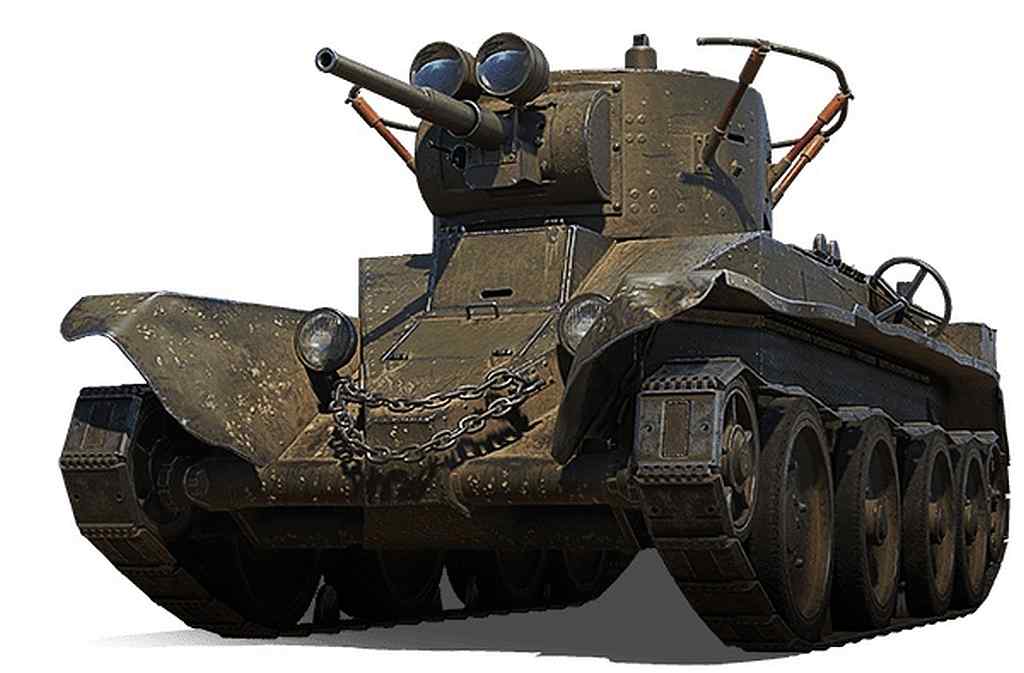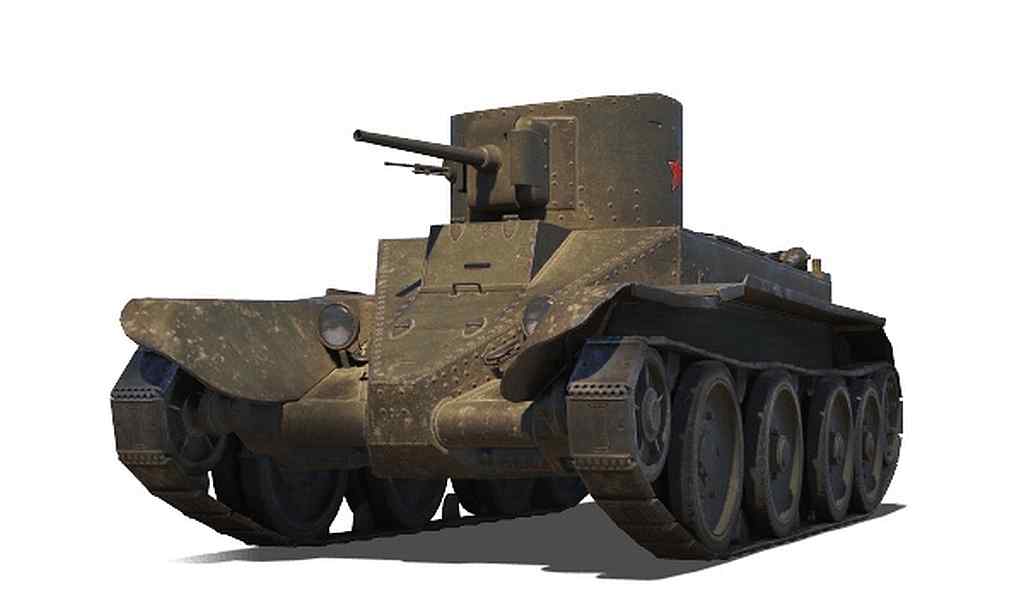WoT 1.23.1 – BT-2 and Bt-5, new stats: buffed
The BT-2 and the BT-5 are regular Soviet light tanks that underwent some changes in the update 1.23. They are level 2 and level 3 tanks, respectively. They have two chassis, two turrets, three guns, two engines, and two radios each.
Dispersion from movement for BT-2 and BT-5 and module repair for BT-5
The changes affected the dispersion from movement, the dispersion from chassis rotation, the module repair cost, the load capacity, the reloading of the entire magazine, the number of shells in the magazine, the aiming time, the gun rate of fire, the dispersion at 100 m, the dispersion after a shot, the average damage per minute, the armor penetration, the specific power, the communication range, the radio weight, and the radio durability of the tanks. The dispersion from movement (max.) of the chassis 1/2 – BT-2 and the chassis 2/2 – BT-5U of both tanks increased from 0.20 (11.00) to 0.22 (12.10) and from 0.26 (14.30) to 0.20 (11.00), respectively. The dispersion from chassis rotation (max.) of the chassis 1/2 – BT-2 and the chassis 2/2 – BT-5 of both tanks increased from 0.20 (7.51) to 0.22 (8.26) and from 0.25 (10.43) to 0.20 (8.34), respectively.
However, the motion spread (max.) of the chassis 2/2 – BT-5 of the BT-2 and the chassis 1/2 – BT-5 of the BT-5 decreased from 0.25 (13.75) to 0.20 (11.00) and from 0.28 (15.40) to 0.22 (12.10), respectively. This means the gun is more stable and accurate when the tank is moving. The dispersion from chassis rotation (max.) of these chassis also decreased from 0.25 (10.43) to 0.20 (8.34) and from 0.28 (11.68) to 0.22 (9.18), respectively. This means the gun is more stable and accurate when the tank is turning. These changes improved the shooting performance of these chassis.
The module repair cost of the BT-5 decreased from 1,686 to 1,226, which means it is cheaper to fix the damaged modules. The load capacity of the chassis 1/2 – BT-5 of the BT-5 increased from 10,720 to 10,800, which means it can carry more weight. These changes improved the general and flexibility performance of the BT-5.


Firepower for BT-5
The reloading of the entire magazine of the gun 2/2 – 37 mm automatic. OKB-2 of the turret 1/2 – BT-5 and the turret 2/2 – BT-7 shielded of the BT-5 increased from 4.99 to 6.71 and from 4.79 to 6.23, respectively. This means it takes longer to reload the entire magazine. The number of shells in the magazine of these guns increased from 5 to 6, which means the tank can fire more shots in a row without reloading. These changes made the firing speed and efficiency of these guns more balanced.
The aiming time of these guns and the gun 3/3 – 45 mm 21-KMT of the turret 2/2 – BT-7 shielded of the BT-5 decreased from 2.59 to 1.92, from 2.40 to 1.82, and from 2.30 to 1.92, respectively. This means it takes less time to aim the gun. The gun rate of fire of these guns also increased from 47.48 to 42.97, from 48.96 to 45.58, and from 31.25 to 33.70, respectively. This means the tank can fire more shots per minute. These changes improved the firing speed and efficiency of these guns.
The dispersion at 100 m of these guns and the gun 1/2 – 37 mm Gun M6 of the turret 2/2 – M5A1 of the BT-5 decreased from 0.44 to 0.40, from 0.43 to 0.38, and from 0.37 to 0.36, respectively. This means the gun is more accurate and reliable at long distances. The dispersion after a shot of these guns also decreased from 4.00 to 1.50, from 3.50 to 1.50, and from 3.50 to 3.00, respectively. This means the gun is more stable and consistent after firing. These changes improved the shooting performance of these guns.
The average damage per minute of the 1 (AP) projectile, the 2 (APCS) projectile, and the 3 (HE) projectile of these guns decreased from 1,899 to 1,719, from 1,899 to 1,719, and from 2,374 to 2,148, respectively, for the turret 1/2 – BT-5 of the BT-5, and from 1,958 to 1,823, from 1,958 to 1,823, and from 2,448 to 2,279, respectively, for the turret 2/2 – BT-7 shielded of the BT-5. This means they can deal less damage over the course of a battle with any type of shell. These changes reduced the damage output of these guns.
The armor penetration of the 1 (AP) projectile and the 2 (APCS) projectile of the gun 3/3 – 45 mm 21-KMT of the turret 2/2 – BT-7 shielded of the BT-5 increased from 55 to 67 and from 90 to 102, respectively. The armor penetration of these projectiles at 500m also increased from 35 to 46 and from 66 to 78, respectively. This means they can penetrate more armor and deal more damage at any distance. These changes improved the damage output of this gun.
Engine and signal range for BT-5
The specific power of the engine 1/2 – M-5-400 and the engine 2/2 – V-3BT of the BT-5 increased from 37.70 to 37.74 and from 39.11 to 39.14, respectively. This means they have more power per ton and acceleration. These changes improved the mobility and performance of these engines.
The communication range of the radio 2/2 – 12LL of the BT-5 decreased from 615.00 to 360.00, which means the tank has less signal range and communication. The radio weight of this radio also decreased from 110 to 100, which means the tank has less weight and more speed. The radio durability (after repair) of this radio also decreased from 200 (150) to 140 (100), which means the radio has less health and survivability. These changes reduced the communication and durability performance of this radio.
These changes made the BT-2 and the BT-5 more effective and powerful in some aspects. The tanks have higher number of shells in the magazine, higher gun rate of fire, higher armor penetration, higher specific power, but lower dispersion from movement, lower dispersion from chassis rotation, lower module repair cost, lower load capacity, lower reloading of the entire magazine, lower aiming time, lower average damage per minute, lower communication range, lower radio weight, and lower radio durability than before.
New changes summarized:
BT-2 (USSR, LT-2, regular). Changes regarding basis 1.23.
Chassis 1/2 – BT-2
• Dispersion from movement (max.): from 0.20 (11.00) to 0.22 (12.10)
• Dispersion from chassis rotation (max.): from 0.20 ( 7.51) to 0.22 (8.26)
Chassis 2/2 – BT-5
• Motion spread (max.): from 0.25 (13.75) to 0.20 (11.00)
• Spread from chassis rotation (max.): from 0.25 (10.43) to 0.20 (8.34)
BT-5 (USSR, LT-3, regular). Changes regarding basis 1.23.
• Module repair cost: from 1,686 to 1,226
Chassis 1/2 – BT-5
• Load capacity: from 10,720 to 10,800
• Motion spread (max.): from 0.28 (15.40) to 0.22 (12.10)
• Dispersion from chassis rotation (max.): from 0.28 (11.68) to 0.22 (9.18)
Chassis 2/2 – BT-5U
• Dispersion from movement (max.): from 0.26 (14.30) to 0.20 (11.00)
• Dispersion from chassis rotation (max.): from 0.26 (13.56) to 0.20 (10.43)
Turret 1/2 – BT-5
Gun 2/2 – 37 mm automatic. OKB-2
• Reloading of the entire magazine: from 4.99 to 6.71
• Number of shells in the magazine: from 5 to 6
• Aiming time: from 2.59 to 1.92
• Gun rate of fire: from 47.48 to 42.97
• Dispersion at 100 m: from 0.44 to 0.40
• Dispersion after shot: from 4.00 to 1.50
• Average damage per minute 1 (AP) projectile: from 1,899 to 1,719
• Average damage per minute 2 (BP) projectile: from 1,899 to 1,719
• Average damage per minute 3 (HE) projectile: from 2,374 to 2,148
Turret 2/2 – BT-7 shielded
Gun 2/3 – 37 mm automatic. OKB-2
• Reloading of the entire magazine: from 4.79 to 6.23
• Number of shells in the magazine: from 5 to 6
• Aiming time: from 2.40 to 1.82
• Gun rate of fire: from 48.96 to 45.58
• Dispersion at 100 m: from 0.43 to 0.38
• Dispersion after shot: from 3.50 to 1.50
• Average damage per minute 1 (AP) projectile: from 1,958 to 1,823
• Average damage per minute 2 (BP) shell: from 1,958 to 1,823
• Average damage per minute 3 (HE) shell: from 2,448 to 2,279
Gun 3/3 – 45 mm 21-KMT
• Aiming time: from 2.30 to 1.92
• Dispersion at 100 m: from 0.37 to 0.36
• Dispersion after a shot: from 3.50 to 3.00
• Armor penetration of 1 (AP) projectile: from 55 to 67
• Armor penetration of 1 (AP) projectile at 500m: from 35 to 46
• Armor penetration of 2 (BP) projectile: from 90 to 102
• Armor penetration of 2 (BP) projectile at 500m: from 66 to 78
Engine 1/2 – M-5-400
• Specific power: from 37.70 to 37.74
Engine 2/2 – V-3BT
• Specific power: from 39.11 to 39.14
Radio 2/2 – 12LL
• Communication range: from 615.00 to 360.00
• Radio weight: from 110 to 100
• Radio durability (after repair): from 200 (150) to 140 (100)
source – wotexpress eu
